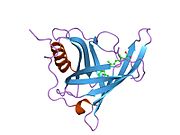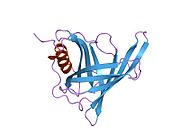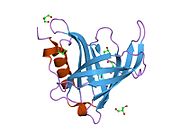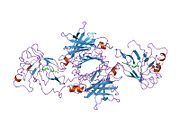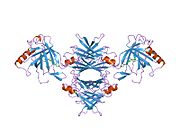Retinol binding protein 4
Template:PBB Retinol binding protein 4, plasma, also known as RBP4, is a protein[1] that in humans is encoded by the RBP4 gene.[2][3]
Function
This protein belongs to the lipocalin family and is the specific carrier for retinol (vitamin A alcohol) in the blood. It delivers retinol from the liver stores to the peripheral tissues. In plasma, the RBP-retinol complex interacts with transthyretin, which prevents its loss by filtration through the kidney glomeruli. A deficiency of vitamin A blocks secretion of the binding protein posttranslationally and results in defective delivery and supply to the epidermal cells.[3]
Clinical significance
Retinol-binding protein 4 has recently been described as an adipokine that contributes to insulin resistance in the AG4KO mouse model.[4] It is secreted by adipocytes, and can act as a signal to other cells, when there is a decrease in plasma glucose concentration.[5]
See also
References
- ^ Rask L, Anundi H, Fohlman J, Peterson PA (1987). "The complete amino acid sequence of human serum retinol-binding protein". Upsala Journal of Medical Sciences. 92 (2): 115–46. PMID 2444024.
{{cite journal}}: CS1 maint: multiple names: authors list (link) - ^ Rocchi M, Covone A, Romeo G, Faraonio R, Colantuoni V (March 1989). "Regional mapping of RBP4 to 10q23----q24 and RBP1 to 3q21----q22 in man". Somatic Cell and Molecular Genetics. 15 (2): 185–90. doi:10.1007/BF01535081. PMID 2928844.
{{cite journal}}: CS1 maint: multiple names: authors list (link) - ^ a b "Entrez Gene: RBP4 retinol binding protein 4, plasma".
- ^ Yang Q, Graham TE, Mody N, Preitner F, Peroni OD, Zabolotny JM, Kotani K, Quadro L, Kahn BB (2005). "Serum retinol binding protein 4 contributes to insulin resistance in obesity and type 2 diabetes". Nature. 436 (7049): 356–62. doi:10.1038/nature03711. PMID 16034410.
{{cite journal}}: CS1 maint: multiple names: authors list (link) - ^ Herman MA, Kahn BB (2006). "Glucose transport and sensing in the maintenance of glucose homeostasis and metabolic harmony". J. Clin. Invest. 116 (7): 1767–75. doi:10.1172/JCI29027. PMID 16823474.
Further reading
External links
- RBP4+protein,+human at the U.S. National Library of Medicine Medical Subject Headings (MeSH)






